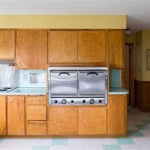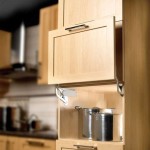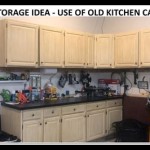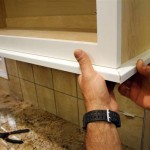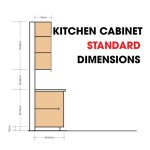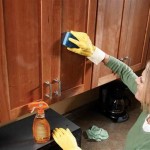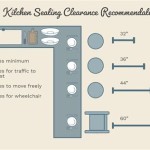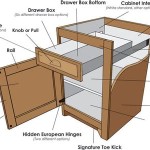Cabinet Skins For Kitchen Cabinets
Kitchen renovations can be costly and time-consuming. However, homeowners seeking an updated look without the hefty price tag and extensive demolition often find cabinet refacing an attractive alternative. Cabinet skins, also known as cabinet refacing veneers, offer a convenient and budget-friendly way to transform the appearance of existing kitchen cabinetry. This article explores the advantages, disadvantages, materials, installation process, and cost considerations associated with using cabinet skins for kitchen cabinets.
Advantages of Using Cabinet Skins
Cabinet skins offer several benefits for kitchen renovations:
- Cost-Effectiveness: Cabinet skins represent a significantly more affordable option compared to replacing entire cabinets.
- Time Savings: The installation process is quicker than a full-scale cabinet replacement, minimizing disruption to daily routines.
- Wide Variety of Styles and Finishes: Homeowners can choose from numerous styles, colors, and textures to match their desired aesthetic.
- Eco-Friendly Option: Refacing existing cabinets reduces waste compared to complete replacement, contributing to sustainability.
- Minimal Disruption: Refacing involves less demolition and mess than traditional cabinet replacement.
Disadvantages of Using Cabinet Skins
While cabinet skins offer numerous advantages, potential drawbacks should also be considered:
- Limited Design Flexibility: Cabinet skins only change the appearance of the cabinet surfaces. They do not alter the layout or functionality.
- Substrate Issues: Pre-existing damage or warping on the cabinet surfaces needs to be addressed before applying the skins for optimal results.
- Not Suitable for All Cabinets: Severely damaged or structurally unsound cabinets may not be suitable candidates for refacing.
Materials Used for Cabinet Skins
Cabinet skins are available in a variety of materials, each with its own set of characteristics:
- Rigid Thermofoil (RTF): A cost-effective option that provides a smooth, durable surface resistant to moisture and stains.
- Vinyl: A versatile material offered in various colors, patterns, and textures, known for its durability and ease of maintenance.
- Wood Veneer: A thin layer of real wood providing a natural and luxurious look, offering various wood species and grain patterns.
Installation Process of Cabinet Skins
The installation of cabinet skins typically involves the following steps:
- Surface Preparation: Thoroughly cleaning and sanding the existing cabinet surfaces ensures proper adhesion.
- Measuring and Cutting: Precise measurements are crucial for accurate cutting of the cabinet skins.
- Adhesive Application: Applying a strong adhesive to the back of the skins ensures a secure bond to the cabinet surfaces.
- Skin Application: Carefully applying the skins to the cabinet surfaces and smoothing out any air bubbles or wrinkles.
- Finishing Touches: Adding new hardware, such as knobs and pulls, completes the updated look.
Cost Considerations for Cabinet Skins
Several factors influence the cost of using cabinet skins for kitchen renovations:
- Material Choice: The type of material selected, such as RTF, vinyl, or wood veneer, impacts the overall cost.
- Cabinet Size and Quantity: The number of cabinets and their dimensions affect the amount of material required.
- Labor Costs: Professional installation adds to the overall expense, while DIY installation can save on labor costs.
- Existing Cabinet Condition: Repairing damaged or warped surfaces before applying the skins may incur additional costs.
Choosing the Right Cabinet Skins
Selecting the appropriate cabinet skins depends on several factors:
- Budget: RTF offers a budget-friendly option, while wood veneer represents a higher-end choice.
- Desired Aesthetic: The chosen material should complement the overall kitchen design and style.
- Durability Requirements: Consider the level of wear and tear the cabinets will experience and choose a material that can withstand it.
- Maintenance Preferences: Some materials require less maintenance than others, which should be factored into the decision.
Maintaining Cabinet Skins
Proper maintenance ensures the longevity and appearance of cabinet skins:
- Regular Cleaning: Wiping down the surfaces with a mild detergent and a soft cloth helps maintain cleanliness.
- Avoid Harsh Chemicals: Using abrasive cleaners or harsh chemicals can damage the finish of the cabinet skins.
- Address Spills Promptly: Wiping up spills immediately prevents staining and discoloration.
Cabinet Skins vs. Other Refacing Options
While cabinet skins offer a convenient and affordable refacing option, other alternatives exist:
- New Cabinet Doors and Drawer Fronts: Replacing only the doors and drawer fronts provides a more substantial update than just skins, but at a higher cost.
- Refinishing: Sanding and repainting or staining existing cabinet surfaces offers another cost-effective way to update the kitchen, but it requires more labor and can be messy.
Assessing Cabinet Condition
Before deciding on cabinet skins, assess the condition of the existing cabinets:
- Structural Integrity: Ensure the cabinets are structurally sound and free from significant damage.
- Surface Condition: Check for any warping, cracking, or peeling that may need to be addressed before applying the skins.
- Layout Suitability: Determine if the existing cabinet layout meets current needs and preferences.

Cabinet Skins Kitchen Bottoms

Diamond At Wood Hoods End Panel Skins

Cabinet Skins Kitchen Bottoms

Everything You Need To Know About Skin Panels For Cabinets

Toe Skin For Covering Exposed Cabinet Kick

Cabinet Ilration Showing Skins Panels Kitchen Molding Trim

What Is Base Skin Definition Of

Cabinet Skin Full Depth To Fully Cover Tops And Bottoms Of Wall Cabinets

Cabinet Side Panel Skin Top And Base Cabinets Maple

Custom Kitchen Cabinets

